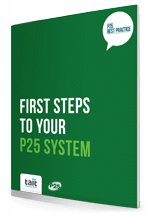


It's time to replace or upgrade your communication system. But which way to go? This first guide outlines some vital steps you can take right now, that will ensure your projects runs smoother.


During specification, you need to identify coverage requirements, ensure interoperability, and establish a budget. Learn a pragmatic approach to system architecture and functionality in the second Best Practice Guide.


RFI, RFP, RFB, and RFQ. Where to begin? And how can you ensure you participate in a competitive process that results in the best solution for your organization? This and more in the third Best Practice Guide.


You have selected a vendor, and now it is time to get your network up and running. This fourth guide address the often confusing sea of documentation required, training your people, and experiencing a smooth migration.


Once your P25 network is up and running, how should you manage it? The complexity of Public Safety communications is increasing, so network management requires significant experience and knowledge. Who will manage it? What should you monitor? How should you prepare for major events? Find out in this P25 Best Practice guide.